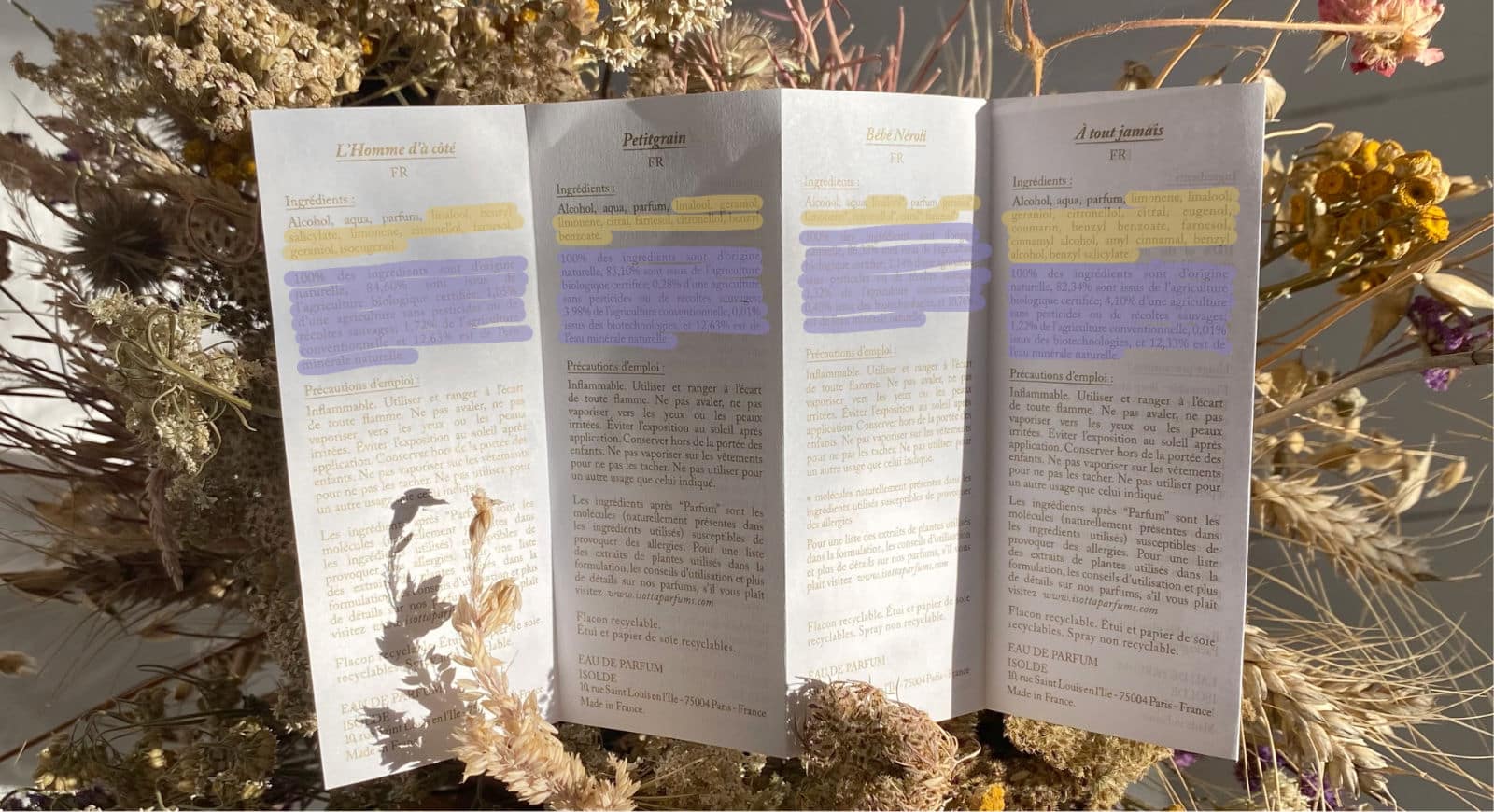Organic perfumes
Here is a little quiz on perfume composition. Are you ready?
1. What is the main ingredient in perfumes?
a. Water
b. Alcohol
c. The perfume concentrate
2. What is inside a perfume that announces a 90% natural composition?
a. 90% of essential oils
b. 90% of alcohol and water and 10% of synthetic molecules
c. 90% of organic plant extracts
3. What remains on your skin 5 minutes after you have put on a conventional perfume?
a. Plant extracts as in advertising
b. synthetic molecules
c. as much synthetic as naturals
d. A lot of synthetics and very little naturals
Answers
Answers: 1b,2b,3d.
What are perfumes made of?
Conventional perfumes
- Alcohol
- Denaturant for alcohol
- Demineralized water
- Synthetic aromatic molecules
- A little essential oils, balms, resins, CO2 extracs, absolutes
- Preservatives
- Solar filters
- Anti decolourizing products so that the perfume colour doesn’t change with light
- Emollients (such as propylenen glycol)
- Stabilizing agents (so that everything stays well blended)
- Phtalates to dilute certain materials
- Colourings
ISOTTA Perfumes
- Organic alcohol
- Natural mineral water
- Essential oils, balms, resins, CO2 extracts, absolutes (extraction without hexane)
- A little natural molecules obtained by biotechnologies (fermentation and/or distillation)
- Ambergris in some formulaes
- Natural preservative (rosemary extract, organic)
You know this little story we tell each other as children:
Pinch-mo and pinch-me are on a boat. Pinch-mo falls in the water. What remains?
With perfumes it’s the same: when we apply/spray a perfume on our skin, what happens?
The alcohol and water evaporate, remain on the skin the perfume concentrate and the other components.
In the case of Isotta perfumes, it’s 100% natural; mainly plant extracts (ambergris when added, see perfume descriptive). In the case of other perfumes, it depends on what is in the concentrate! If the maker announces 90% natural, which will become a fashionable selling argument, will remain, as a consequence, 10% of synthetic, preservatives etc (see “conventional perfumes” list) that will penetrate your body. Each time you put perfume on, maybe each day. It doesn’t mean a lot of essential oils have been put in at all.
Labels are complicated to read. If you have questions, don’t hesitate to ask them by sending an email to this address: contact@isottaparfums.com

100% natural ingredients
Isotta perfumes are 100% natural.
The choice of raw materials is focused on organic certified essential oils and plants harvested in the wild (among which woods).
When those are not available, we have no other choice but that of conventional ingredients. (Orris and ambrette for instance). The absolutes extracted with petrochemical solvents are never chosen.
We also use, in very small quantities, molecules issued from biotechnologies, that is obtained by natural means, without any intervention at any moment of petrochemical elements (fermentation is one of those processes).
The organic alcohol is french, and comes from wheat.
Water is natural mineral water.
The preservative is a powerful antioxidant natural extract.
So our fragrances are composed of 100% natural ingredients, with a minimum of conventional ingredients, and a level of organic+wild varying between 83,38 and 87,52%. It should be noted that, according to the law, natural mineral water cannot be counted in the percentage of wild ingredients (!), in which case we would come up to a total varying between 96,02 et 99,28% of water+organic+wild. The rest being ingredients of conventional agriculture and/or natural molecules obtained from biotechnologies.
See ingredients descriptive on each perfume page.

Certified organic and wild ingredients
Isotta perfumes do not have an organic certification.
The percentages of already certified organic ingredients and of those harvested in the wild speak for themselves. You will find usage instructions at the end of each perfume page in the « collection » of the main menu.
The various organic labels are of course very useful to the consumer. They cost him a lot too, because the certification cost is reflected in the final price. In the case of perfumes, it did not seem judicious to do this, because our perfumes fill in those requirements and their « product file » is reviewed by a group of licensed toxicologists who carefully check each detail including labelling. It would not be legal for us to announce « organic » if the product wasn’t.
Allergens
26 allergens are listed among the raw materials and molecules used in perfumery, of which 19 are present in natural materials (essential oils) and 2 are raw materials (tree mosses, of which the famous oakmoss).
When they are present in Isotta perfumes, those allergens are reported, in accordance to the law, in decreasing order and when their presence in the final composition of a perfume is over 0,001%. (see the usage precautions attached at the end of each perfume description).
Allergens are annoying only for the people sensitive to them, which should represent between 1 to 3% of the population according to estimates.
They would, in case of allergy, cause itching and redness, in no case a vital emergency. If you ever feel such discomfort, the list of allergens will help your allergist finding the culprit by crossing data with other allergen lists present on cosmetics that cause you problem.
All this may sound quite alarming, and give a bad image of essential oils, especially with the numerous appreciations of consumer websites classifying cosmetics in function of this parameter.
We may point that those websites never make big cases out of food allergens which can put one’s lives at risk. In effect we never see bad marks for fruit and vegetables nor for seafood restaurants (that’s lucky!), even though they sell plenty of allergens! There is no reason to depreciate those products, they are an inconvenient only to the persons sensitive to them.
The list of allergens is sufficient in cosmetics to warn of their presence, again not dangerous in this case. There is no warning on forests or springtime – fortunately !- however they abound in pollens !
